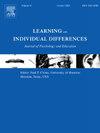学术浮力的性别差异:一项元分析
IF 3.8
1区 心理学
Q1 PSYCHOLOGY, EDUCATIONAL
引用次数: 0
摘要
学术浮力帮助学生成功地克服日常的学术挑战、挫折和逆境。它与一系列积极的结果有关,包括幸福感、积极性、参与度和成就。文献中有一种趋势表明,女学生报告的学业浮力水平低于男学生。考虑到学术浮力对不同结果的影响,本荟萃分析试图确定这种性别差距是否在文献中一致存在,如果是的话,它在多大程度上存在,以及哪些因素可以缓和其影响。支持我们的假设,性别有显著的效应大小(赫奇斯的g = 0.21),男性在学术浮力方面的得分明显高于女性。调节分析产生了混合的证据,性别差距随着语言背景和使用的评分量表的功能而不同。讨论了心理教育实践和未来研究的建议。教育相关性学术浮力帮助学生应对每天的学术挑战、挫折和逆境。然而,有一个令人担忧的趋势表明,女学生报告的学业浮力水平低于男学生。鉴于学术浮力对不同结果的影响,重要的是要具体确定这种性别差距是否存在,如果存在,在多大程度上存在,以及哪些因素可以缓和其影响。这项荟萃分析的结果显示,男性的学业浮力明显高于女性。实践的努力描述,旨在直接提高学术浮力在女性和维持学术浮力在男性。主持人建议进一步以实践为导向的指导,特别是对英语环境下的女性(而性别影响在非英语环境下的男性和女性中并不那么明显)。本文章由计算机程序翻译,如有差异,请以英文原文为准。
Gender differences in academic buoyancy: A meta-analysis
Academic buoyancy assists students to successfully overcome everyday academic challenge, setback, and adversity. It is associated with a range of positive outcomes, including wellbeing, motivation, engagement, and achievement. There is a trend in the literature suggesting that female students report lower levels of academic buoyancy than their male counterparts. Given the yields of academic buoyancy for diverse outcomes, the present meta-analysis sought to ascertain if this gender gap does exist consistently across the literature, and if so, to what extent it does and what factors may moderate its effects. Supporting our hypothesis, there was a significant effect size for gender (Hedges' g = 0.21), with males scoring significantly higher than females in academic buoyancy. Moderator analyses yielded mixed evidence, with the gender gap differing as a function of language context and rating scale used. Recommendations for psycho-educational practice and future investigations are discussed.
Educational relevance
Academic buoyancy assists students to navigate everyday academic challenge, setback, and adversity. However, there is a concerning trend suggesting that female students report lower levels of academic buoyancy than their male counterparts. Given the yields of academic buoyancy for diverse outcomes, it is important to concretely ascertain if this gender gap does exist, and if so, to what extent it does and what factors may moderate its effects. The findings from this meta-analysis showed that males report significantly higher academic buoyancy than females. Practice efforts are described, aimed at directly boosting academic buoyancy among females and sustaining academic buoyancy among males. The moderators suggested further practice-oriented guidance especially for females in English-speaking contexts (whereas gender effects were not so salient among males and females from non-English-speaking contexts).
求助全文
通过发布文献求助,成功后即可免费获取论文全文。
去求助
来源期刊

Learning and Individual Differences
PSYCHOLOGY, EDUCATIONAL-
CiteScore
6.60
自引率
2.80%
发文量
86
期刊介绍:
Learning and Individual Differences is a research journal devoted to publishing articles of individual differences as they relate to learning within an educational context. The Journal focuses on original empirical studies of high theoretical and methodological rigor that that make a substantial scientific contribution. Learning and Individual Differences publishes original research. Manuscripts should be no longer than 7500 words of primary text (not including tables, figures, references).
 求助内容:
求助内容: 应助结果提醒方式:
应助结果提醒方式:


